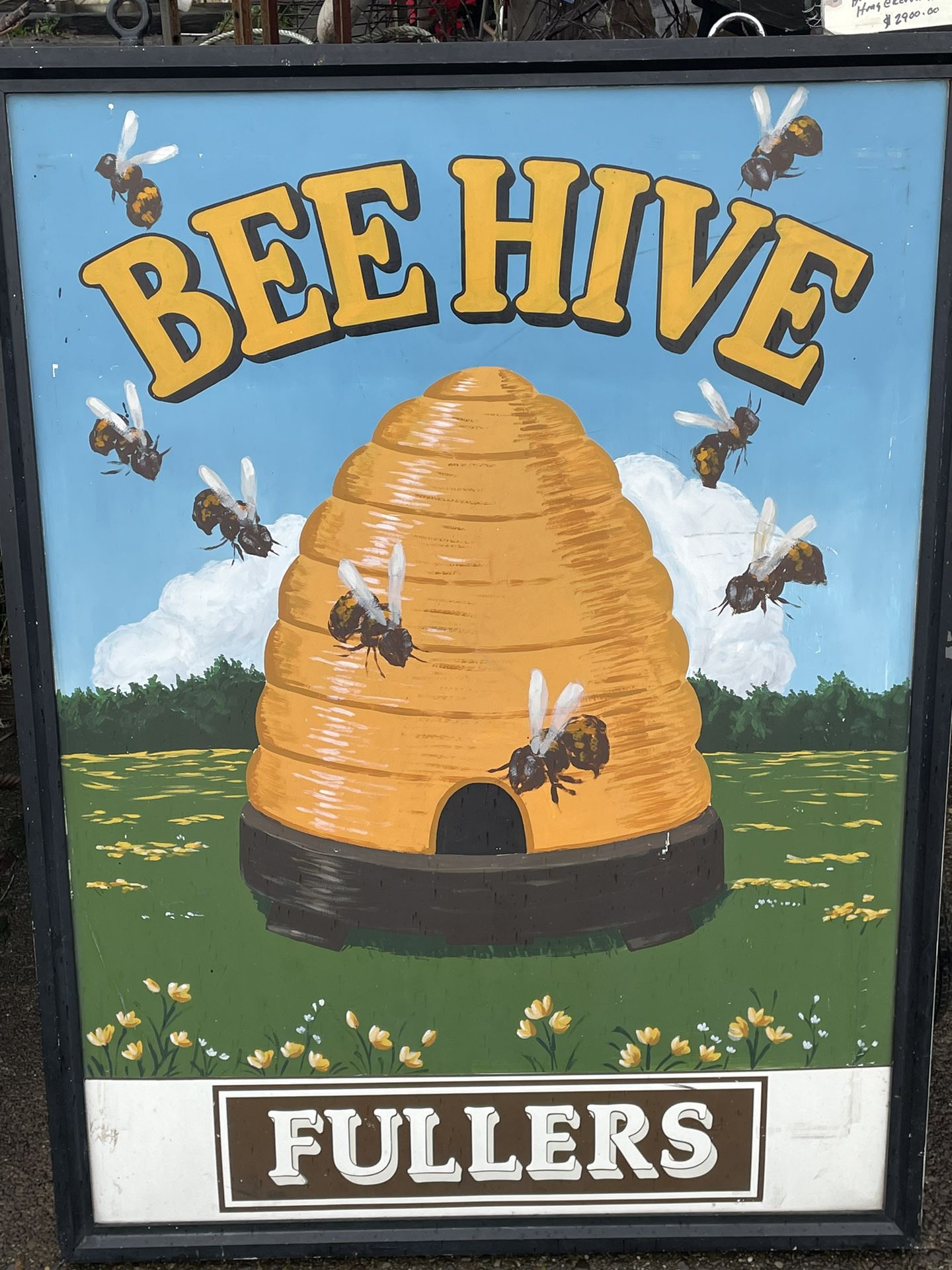Authentic Antique British Vintage "Bee Hive" Fullers Pub Sign
$2,000
Last updated 3 months ago in Ocean City, WA
Condition: Used (normal wear)
Listed in categories: Collectibles & Art - Antiques
Chat securely on the app
Sold by

Additional images
Description
You are looking at a RARE Vintage English pub sign for the "Bee Hive" a Fullers pub. Large scale sign - wonderful fun design - a huge hive with bees buzzing around! 36 5/8" x 48.5" x 1.75" d. THIS SIGN HUNG IN THE RED DOOR IN FREMONT, WASHINGTON FOR YEARS. The Red Door is no more.🥃 cheers to the memories. NO SHIPPING! PICK UP ONLY! Originally there were no bar signs, at least not the way that we know them now. The tradition seems to have originated in Rome at a very basic level, and moved into Britain from there. But they weren’t the wooden barsigns or metal signs like we see now, the Romans used to hang vines outside of buildings that sold wine in order to tell people they could purchase it there. The Romans called these buildings the ‘Tabernae’. This started being done in Britain after the Romans invaded in 43 A.D. but it was changed a little bit from the original form. The Romans soon discovered that vines were hard to find in Britain, and they started substituting vines with small evergreen bushes or other foliage. Around the 12th century the British started to use the first actual bar signs. They opted for painted pictures instead of words because at the time most people were illiterate, so images were easier to understand. And these images were usually very obvious, so pictures of tankards and other alcohol related things were the norm at this time. This didn’t last very long though, before the barsigns evolved once again. In the year of 1393 there was a new law passed by King Richard II that stated that every inn and pub had to display a white stag, which was his personal emblem. The reason behind passing this law was supposedly to make it easier for ale-conners to identify businesses that sold beer. Ale-connors officers whose jobs were to make sure that any and ale being sold was of a proper quality, this was a very prestigious position at the time. If an establishment that sold beer didn’t have a hanging bar sign with a white stag on it then they would be punished by having to give up all their beer. So it’s no surprise that most people complied and soon enough most of the pubs in Britain had barsigns. Ever since that point in history, bar signs in Britain have continued to evolve into whatever fit into British culture at the time. ‘The Crossed Keys’ were popular for a while, as they were the emblem of St. Peter and religious meaning was popular for some time before the Reformation. After King Henry VIII split with the Catholic church, a lot of bar signs were changed to have non-religion based themes. Some common alternatives that pubs changed to were ‘The King’s Head’ or ‘The Rose and the Crown’ as well as other names that gave more significance to the crown. In 1603 another king passed a law that changed bar signs yet again, when James I and VI of Scotland took the throne. He said that the red lion of Scotland should be displayed on not only pubs but all buildings of importance in Britain. ‘The Red Lion’ then became one of the most popular pub names in all of history and therefore graced many bar signs with its imagery. So if you’ve heard of this name before now you know why, it has stayed popular to this day and is a nostalgic reference to a time in history. And in fact, a lot of bar signs designs are linked to royals in some way or another. Edward IV inspired the name ‘White Lion’, and ‘White Boar’ was the emblem of Richard III and was used a lot during his reign. But royalty aren’t the only ones that pubs were named in honour of, oftentimes pubs are named after famous figures in history or memorable historical events. Some examples of famous people include Shakespeare and the Duke of Wellington, whereas famous events that might be referenced would be ‘The Highwayman’ or ‘The Smugglers Haunt’. Even in recent times these names have been used as a way to pay homage to the past, even more than barsigns themselves already do by keeping up this ancient tradition. Nowadays hanging bar signs are much more varied and there are still a lot of them, in no way are they a thing of the past. They’re more personalised but still lose none of their charm in the process, and perhaps even gain more charm in their personality. When you’re standing in front of a bar or pub now, versus hundreds of years ago, you could see not only a wooden bar sign but maybe a metal bar sign. There is much more diversity, but one thing all barsigns have in common is their history and shared tradition. It’s a beautiful thing to see that while change is necessary, some things stay charmingly the same throughout the course of time. THANKS FOR LOOKING NO SHIPPING! PICK UP ONLY!
Save, Report, and Share
Item location map
Map is approximate to keep seller’s location private.
Related searches
- Antique dresser
- Antique furniture
- Antique desk
- Antique table
- Antique mirror
- Antique clocks
- Antique chairs
- Antique cabinets
- Antique bottles
- Antique armoire
- Antique lamps
- Antique dolls
- Antique china
- Antique glass
- Vintage lamp
- Vintage pyrex
- Candelabra